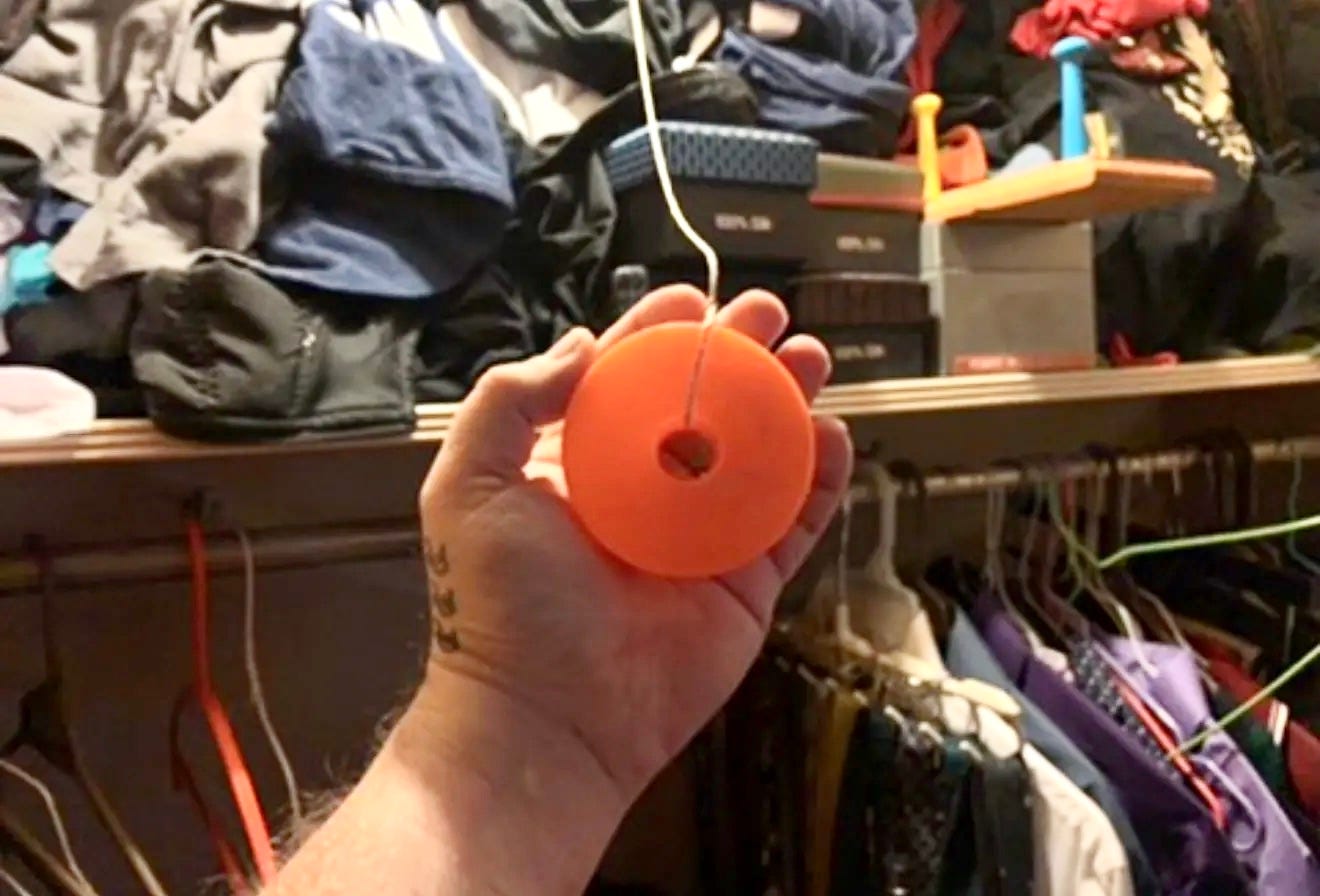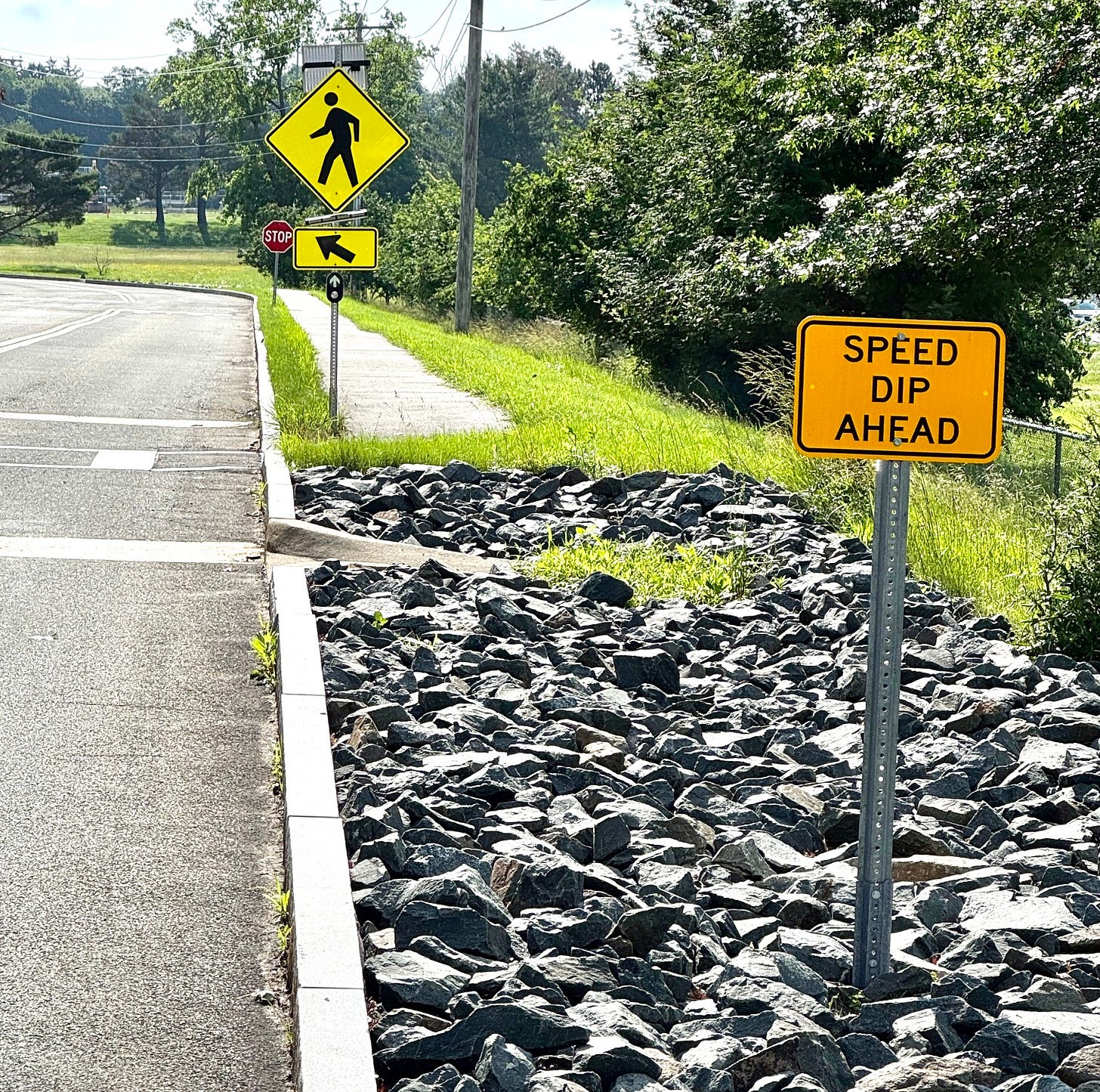Show and Tell: The Fisher-Price Donut
How a child's toy resonated through several generations of a family.
Show and Tell is an occasional recurring feature of Inconspicuous Consumption, with most of the entries contributed by the site’s readers. Today’s installment is by reader Ted Anthony. You can see additional Show and Tell posts here. — Paul
By Ted Anthony
When I was about three years old, I was afraid of the dark in my room at night. My mother came up with an elegant solution.
She went to my early-1970s toy pile and extracted a plastic Fisher-Price toy donut — a thick, bright-orange disc with a hole in the middle, designed for a child’s hand. She ran a string from the pull-chain light switch in my closet, all the way down to a toddler’s level, and tied the donut to the end of it. She showed me how to get up out of bed, pad over to the closet, and pull on the donut when I felt afraid.
“Now,” she said, “you control the light.”
Years passed. As I grew taller, the string migrated upward, diligently and gradually, snip by snip. My mother made certain of that.
By the time my freshman year of college was at hand, the donut hung at eye level of the 6-foot man I had become.
A few days before I left my childhood behind and headed off to college, I closed myself in my bedroom and spent several minutes tugging at the donut. The closet bulb went on, off, on, off, on.
At that moment, I felt like I controlled very little. But I still controlled the light.
I left for 20 years. As a reporter and editor for the Associated Press, I went all the way around the world: war zones, distant Chinese villages, sites of plane crashes and mass shootings. But I was always drawn back home to visit. And the donut remained. After 9/11, when I was sent to Afghanistan and Iraq, the donut hung in the back of my mind, a mental talisman of comfort and safety. If I could reach it again, surely I would be okay. I did, and I was.
In 2007, my parents left the house they had built so long ago and moved into a retirement community. My family relocated back to Pittsburgh to be near them, and we moved into the house. My oldest son, then four, got my old room. My mother made sure to re-extend the string before she left. Someone shorter needed to control the light again.
My parents faded, as parents do. Alzheimer’s took my father and took its cruel, methodical time. Then dementia encircled my mother.
Just before Thanksgiving 2018, she began her final decline. You know the story. From walker to wheelchair, wheelchair to bed. Confusion. Sadness. Bewilderment. “I’m just stuck,” she lamented to me. “I don’t control anything anymore.”
I spent much of her morphine-induced final days sleeping on the floor next to her, feeding her orange sherbet and sips of Barefoot Cabernet from single-serving bottles. At night, I sang to her quietly some of the songs we’d listened to on AM radio together when I was a boy. I sang Paul Simon’s “Slip Sliding Away,” one of our favorites, now fraught with searing new meaning. When I got to Billy Joel’s “I Love You Just the Way You Are,” she summoned enough energy to rasp: “That’s how I feel about you.”
On her final morning of consciousness, I woke up on the floor and saw her hand reaching toward me over what was going to be her deathbed. “Are you still there?” she whispered. She couldn’t sit up far enough to check on her own.
“I’m here,” I said. “Are you?”
She responded: “I think so.”
My mother died just hours into December of that year. Two days later, I took a pair of scissors and went into my son's room. He was now 15 years old. With him watching, I opened the closet door, reached up, and snipped the string. For the first time since Richard Nixon's first term, the orange donut was absent from the closet where it had hung for so long.
The following morning, at the funeral home, we spent some time with my mother before our final goodbye. My younger son placed a baseball next to her, signed in his just-emerging cursive. Then, carefully, I laid the donut by her side. Gently, touching her for the last time, I threaded the string through the fingers of her right hand before they closed the casket.
It made so much sense. Our roles, so many years later, were now reversed. At long last, she had become the one who needed to control the light.
Versions of this story previously appeared in the PennStater magazine in 2019, and on Ted Anthony’s Unsorted but Significant Substack last month.
Paul here. Man, what a great story!
Full disclosure: Ted Anthony wrote a story about me and my 1990s zine, Beer Frame: The Journal of Inconspicuous Consumption, about 30 years ago. We’ve stayed in touch since then, and I was very excited when he launched his Substack, Unsorted but Significant, in 2023. He and I have similar storytelling sensibilities, and a similar fascination with the inconspicuous. When the piece about the toy donut recently appeared on his site, I thought it would make a great “Show and Tell” entry here on IC, so I asked if I could cross-post it here. He readily agreed. Big thanks to him for sharing this story with us.
Boundary Issues, Continued
The virtual ink had barely dried on last week’s series of articles about border-related issues than a New Jersey politician tried to ignite a border dispute with neighboring Delaware.
The issue involves a small Delaware exclave on the New Jersey side of the Delaware River, as indicated by the orange arrow above. Let’s zoom in for a closer look:
Why does that little knob of land, known as Finns Point, belong to Delaware? According to this article, it’s because the border was originally stipulated to be the low-tide mark on the New Jersey shore. The river was later dredged to facilitate greater shipping access, with the dredged material added to the marshy low-tide area to create what is now Finns Point as solid land. The question of which state could legally lay claim to the newly formed promontory has gone to the U.S. Supreme Court three times, with Delaware winning on all three occasions.
Despite this, a New Jersey state senator introduced legislation the other day to claim this land for the Garden State. It appears to be a publicity stunt with no chance of success, but it’s a good reminder that even long-established borders can be controversial.
(Big thanks to Phil Hecken for bringing this development to my attention.)
Bumps, Humps, Etc., Continued
We’ve previously seen speed bumps, humps, lumps, and BOMPs, but reader Mike Engle has spotted something new at Hudson Valley Community College in Troy, N.Y.: a speed dip. A sign is shown above, and here’s a closer look at the dip itself:
Interesting! And if rain water collects in the recessed strip, it could arguably be called a speed sump! I hereby move that we refer to it as such going forward.
Paul Lukas has been obsessing over the inconspicuous for most of his life, and has been writing about those obsessions for more than 30 years. You can contact him here.















Wow that story was a gut punch. Wasn't expecting to be crying in the office on a Tuesday morning.
Thank you for sharing your powerful story of the Fischer Price donut. Thru tears I remember my own father's passing, not with sorrow, but with tenderness. Your words were a gift to me.